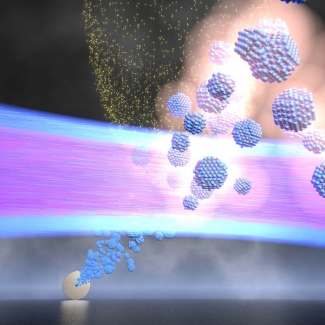When research associate Wei Xiong and graduate student Dan Hickstein studied quantum dots by shining laser light on them in the gas phase, they got some surprising results. The tiny chunks of material responded differently to series of two laser pulses — depending on their size. Scientists already knew that most of their quantum dots would end up with at least part of an electron wandering around outside of them for some period of time. However, Xiong and his colleagues showed that the electrons from the smallest quantum dots traveled the farthest away.
More importantly, the researchers found that it was much easier for a second laser pulse to knock electrons completely out of the smaller quantum dots than it was to pry the electrons loose from the larger dots (Figure 1). At first, this behavior seemed a little strange, but soon the researchers figured out what was going on.
When a laser pulse excites an electron inside a quantum dot, the electron will spend some of its time wandering around outside of quantum dot. However, the amount of time that the electron spends outside is much longer for the smaller quantum dots. In fact, electrons typically wander around outside the little guys roughly 10 percent of the time.
“That ten percent is the important part,” explained Xiong. “If you’re an electron hanging partly outside a quantum dot, there are good reasons why it’s easier to kick you all the way out. First, you cannot absorb photons (from laser light) as easily if you’re inside a quantum dot. Second, even if you absorb a photon and try to escape, there’s a chance you won’t make it all the way out of the quantum dot.”
In other words, the farther away an electron wanders from its quantum dot, the easier it is for a second light pulse to knock it all the way out of the ball park.
Xiong and Hickstein were assisted in this work by graduate students Jennifer Ellis and Chengyuan Ding; research associate Ellen Keister; Gordana Dukovic, assistant professor of chemistry and biochemistry, and her graduate student Kyle Schnitzenbaumer; Jose-Luis Jimenez, associate professor of chemistry and biochemistry and Fellow of the Cooperative Institute for Research in Environmental Sciences (CIRES), and his graduate student Brett Palm; as well as Fellows Margaret Murnane and Henry Kapteyn.
Xiong and his colleagues are interested in studying quantum dots and other nanostructures because they’re half way between atoms and solids. Consequently, they behave differently than other materials. For instance, quantum dots can absorb light 100–1000 times better than most substances. However, efforts to use quantum dots to improve the efficiency of solar panels haven’t paid off yet. It’s been difficult to get electrons excited by sunlight to wander out of the quantum dots and into a wire.
Here’s where the basic research underway by Xiong and his colleagues may be able to help. They’ve just made the first direct measurements of the amount of time that the excited electrons spend outside of various sizes of quantum dots after being excited by laser light. They’re also shown that these excited wandering electrons are easier to remove from the quantum dots with a second pulse of laser light. They may even have made a significant step towards understanding how best to use quantum dots to harvest the Sun’s energy.
This project was made possible via a collaboration of three groups, two at the University of Colorado and one in JILA. The experiment included two instruments from the Kapteyn/Murnane group, a special aerodynamic lens and source of nanoparticles from the Jimenez lab, and assistance with sample preparation and theoretical understanding of the quantum dots from the Dukovic group.
The next step for Xiong and his colleagues is to seek a better understanding of the basic physics of how electrons move from quantum dots to other nanomaterials. Initially, they plan to attach quantum dots to quantum rods, molecules, and other nanostructures to study more about the physics of electron transfer. — Julie Phillips




